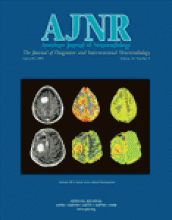Abstract
BACKGROUND AND PURPOSE: Recent interest has emerged in the use of pharmacologic methods to maximize blood oxygenation level-dependent (BOLD) signal intensity changes in functional MR imaging (fMRI). Adenosine antagonists, such as caffeine and theophylline, have been identified as potential agents for this purpose. The present study was designed to determine whether caffeine-induced decreases in cerebral perfusion result in enhanced BOLD responses to visual and auditory stimuli.
METHODS: MR imaging was used to measure resting cerebral perfusion and stimulus-induced BOLD signal intensity changes in 19 patients. We evaluated the relationship between resting cerebral perfusion and the magnitude of BOLD signal intensity induced by visual and auditory stimulation under caffeine and placebo conditions.
RESULTS: The data showed that changes in resting cerebral perfusion produced by caffeine are not a consistent predictor of BOLD signal intensity magnitude. Although all cerebral perfusion was reduced in all study participants in response to caffeine, only 47% of the participants experienced BOLD signal intensity increase. This finding was independent of the participants’ usual caffeine consumption.
CONCLUSION: The data presented herein show that the relationship between resting cerebral perfusion and the magnitude of BOLD signal intensity is complex. It is not possible to consistently enhance BOLD signal intensity magnitude by decreasing resting perfusion with caffeine. Future studies aimed at evaluating the relationship between perfusion and BOLD signal intensity changes should seek a means to selectively modulate known components of the neural and vascular responses independently.
- Copyright © American Society of Neuroradiology












